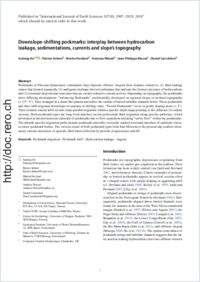Downslope-shifting pockmarks: interplay between hydrocarbon leakage, sedimentations, currents and slope’s topography
- Ho, Sutieng Department of Geosciences, National Taiwan University, Taipei, Taiwan - Unit of Earth Sciences, University of Fribourg, Switzerland
- Imbert, Patrice Total-CSTJFPau, France
- Hovland, Martin Center for Geobiology, University of Bergen, Norway
- Wetzel, Andreas Geological Institute, University of Basel, Switzerland
- Blouet, Jean-Philippe Unit of Earth Sciences, University of Fribourg, Switzerland
- Carruthers, Daniel Companie Genéral Géophysique, Llandudno, UK
-
01.11.2018
Published in:
- International Journal of Earth Sciences. - 2018, vol. 107, no. 8, p. 2907–2929
English
Pockmarks in Pliocene-Quaternary continental slope deposits offshore Angola show features related to: (1) fluid leakage craters that formed repeatedly, (2) authigenic methane-derived carbonates that indicate the (former) presence of hydrocarbons and (3) erosional–depositional structures that are clearly related to current activity. Depending on topography, the pockmarks show differing development: “Advancing Pockmarks” preferentially developed on regional slopes or inclined topography (> 2.5°–3°). They arranged in a chain-like pattern and mimic the outline of buried turbidite channels below. These pockmarks and their infill migrated downslope in response to shifting vents. “Nested Pockmarks” occur in gently sloping areas (< 2°). Their isolated conical infill records slope-parallel migration within a specific depth range pointing to the influence of contour currents. Both pockmark types are long- lived and they record preferential fluid migration along specific pathways, which developed at the downcurrent sidewalls of pockmarks due to flow separation initiating “cavity flow” within the pockmarks. The durable specific migration paths include pockmark sidewalls, vertically stacked erosional-interface of sediment waves, or entire pockmark bodies. The vertical extent of both pockmark types from End Miocene to the present-day seafloor documents various intensities of episodic fluid bursts followed by periods of quiescence and fill.
- Faculty
- Faculté des sciences et de médecine
- Department
- Département de Géosciences
- Language
-
- English
- Classification
- Geology
- License
-
License undefined
- Identifiers
-
- RERO DOC 323827
- DOI 10.1007/s00531-018-1635-5
- Persistent URL
- https://folia.unifr.ch/unifr/documents/307467
Statistics
Document views: 119
File downloads:
- pdf: 862
